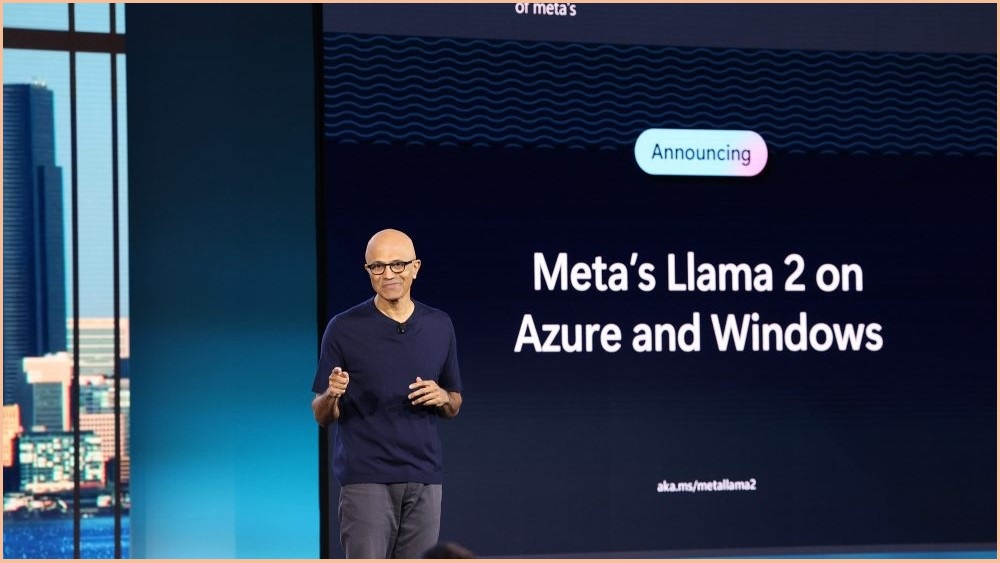The race to market with Artificial Intelligence products has ramped up with Microsoft and Meta joining forces on the release of Llama 2, Meta’s latest iteration of its open-source Large Language Model that will see the product incorporated into Microsoft products.
Microsoft CEO, Satya Nadella, speaking at the company’s Inspire Conference yesterday, said “Meta has been doing phenomenal work in innovating with open models, and Llama has captured the imagination of what open source and open AI models can do.”
The partnership will see Meta’s large language model available through Microsoft Azure and Windows and Amazon Web Services along with Meta's own website.
At the event, Microsoft also announced pricing for its AI driven Copilot for Microsoft 365 based on the company’s OpenAI partnership.
The corporate product will cost $US30 per user for business accounts, as well as Bing Chat Enterprise, a privacy-focused version of the AI chatbot with beefed up security for handling sensitive business data.
“Between Bing Chat Enterprize and Microsoft 365 Copilot, knowledge work and knowledge workflow is going to be completely transformed,” Nadella promised.
The Microsoft CEO went on to emphasise the company’s corporate AI service will not use customers’ data to train its model and clients’ information and models will be protected as part of the company’s push to boost corporate confidence in its Artificial Intelligence products.
Meta founder Mark Zuckerberg added in a statement, “we’re partnering with Microsoft to introduce Llama 2, the next generation of our open source language model. Llama 2 will be available for free for research and commercial use.
“Today we’re releasing pretrained and fine-tuned models with 7B, 13B, and 70B parameters. Llama 2 was pretrained on 40% more data than Llama 1 and has improvements to its architecture. For the fine-tuned models, we collected more than 1 million human annotations and applied supervised fine-tuning and reinforcement learning with human feedback (RLHF) with leading results on safety and quality.”
The partnership comes as vendors ramp up their promises of AI’s benefits. In Australia, Microsoft and the Tech Council today released the Australia’s Generative AI Opportunity report claiming Generative AI could contribute as much as $115 billion a year to Australia’s economy by 2030.
The report identified two major channels for growth through boosting the productivity of existing industries and creating new products and services.
Kate Pounder, Tech Council CEO, said “in this time of high inflation and low productivity growth, our economy needs a productivity shot in the arm.
“The report shows the enormous potential for generative AI to catalyse growth and innovation across a wide range of sectors, shaping a prosperous future for our nation.”
Most of the gains would result from increases in workforce productivity through the automation of routine tasks, the report said while identifying the potential to automate and augment 44 per cent of Australian workers’ task hours at its current level of capability.
The report also estimates that new products and services created using generative AI will power new jobs and businesses, collectively contributing between $5 billion and $10 billion to Australia’s economy.
Along with identifying healthcare, manufacturing, retail, and professional and financial services, the report also noted industry and government are at a critical juncture in the adoption of generative AI, calling for deeper collaboration across sectors for Australia to capture the economic benefits promised by the technology.
The report recomended actions for Australia to take the opportunity and become a global leader in generative AI. The report proposed include defining the benefits and vision for generative AI in Australia, assessing readiness, incentivising adoption and innovation, upskilling the workforce, and developing responsible AI governance frameworks.
“Making the most of this opportunity will require a collaborative effort across government and industry, particularly to upskill our workforce, provide regulatory clarity and drive uptake of responsible AI practices,” Pounder concluded.
“Australia must ensure swift and responsible adoption of generative AI to fully capture the depth and breadth of this opportunity.”










